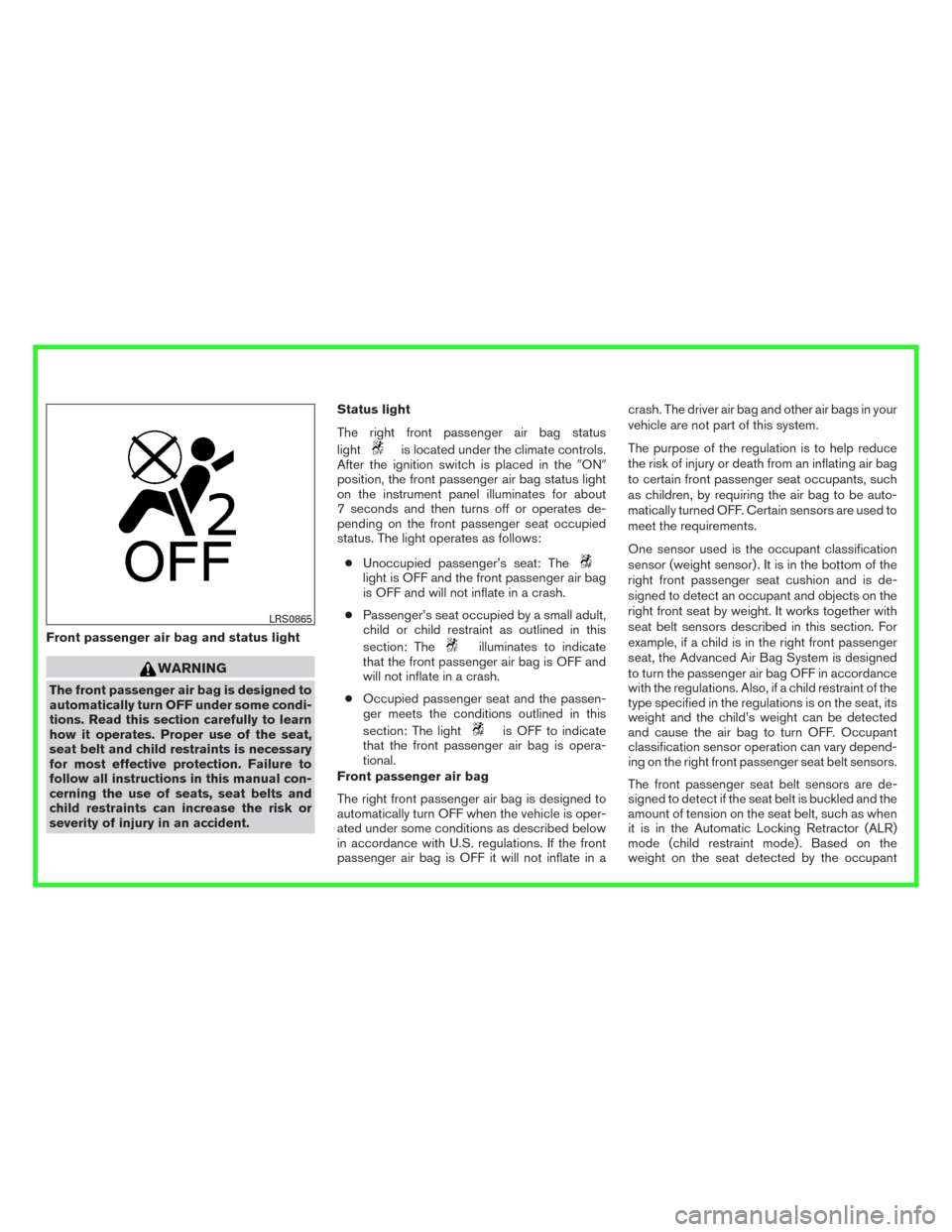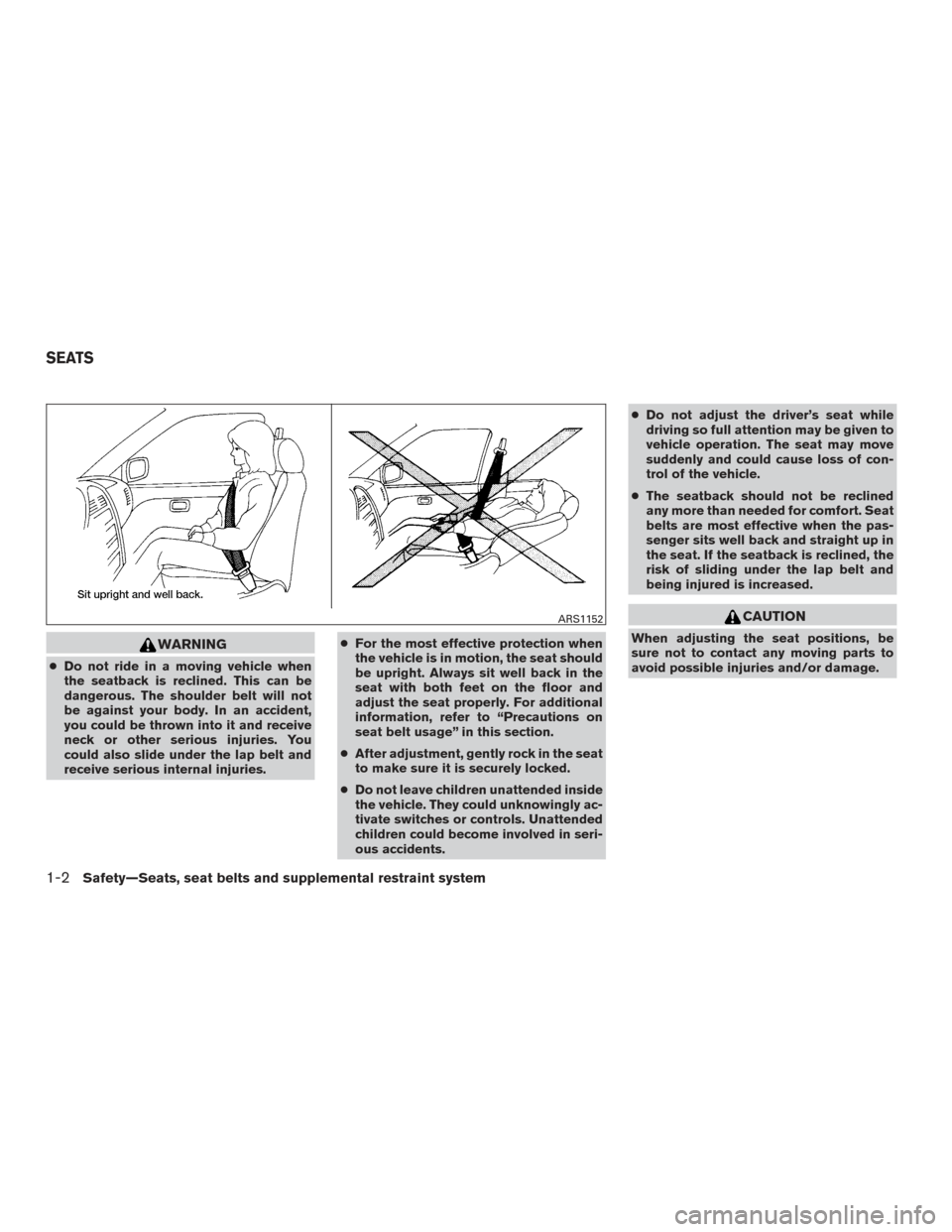Page 3 of 457

Front passenger air bag and status light
WARNING
The front passenger air bag is designed to
automatically turn OFF under some condi-
tions. Read this section carefully to learn
how it operates. Proper use of the seat,
seat belt and child restraints is necessary
for most effective protection. Failure to
follow all instructions in this manual con-
cerning the use of seats, seat belts and
child restraints can increase the risk or
severity of injury in an accident.Status light
The right front passenger air bag status
light
is located under the climate controls.
After the ignition switch is placed in the�ON�
position, the front passenger air bag status light
on the instrument panel illuminates for about
7 seconds and then turns off or operates de-
pending on the front passenger seat occupied
status. The light operates as follows:
●Unoccupied passenger’s seat: The
light is OFF and the front passenger air bag
is OFF and will not inflate in a crash.
●Passenger’s seat occupied by a small adult,
child or child restraint as outlined in this
section: The
illuminates to indicate
that the front passenger air bag is OFF and
will not inflate in a crash.
●Occupied passenger seat and the passen-
ger meets the conditions outlined in this
section: The light
is OFF to indicate
that the front passenger air bag is opera-
tional.
Front passenger air bag
The right front passenger air bag is designed to
automatically turn OFF when the vehicle is oper-
ated under some conditions as described below
in accordance with U.S. regulations. If the front
passenger air bag is OFF it will not inflate in acrash. The driver air bag and other air bags in your
vehicle are not part of this system.
The purpose of the regulation is to help reduce
the risk of injury or death from an inflating air bag
to certain front passenger seat occupants, such
as children, by requiring the air bag to be auto-
matically turned OFF. Certain sensors are used to
meet the requirements.
One sensor used is the occupant classification
sensor (weight sensor) . It is in the bottom of the
right front passenger seat cushion and is de-
signed to detect an occupant and objects on the
right front seat by weight. It works together with
seat belt sensors described in this section. For
example, if a child is in the right front passenger
seat, the Advanced Air Bag System is designed
to turn the passenger air bag OFF in accordance
with the regulations. Also, if a child restraint of the
type specified in the regulations is on the seat, its
weight and the child’s weight can be detected
and cause the air bag to turn OFF. Occupant
classification sensor operation can vary depend-
ing on the right front passenger seat belt sensors.
The front passenger seat belt sensors are de-
signed to detect if the seat belt is buckled and the
amount of tension on the seat belt, such as when
it is in the Automatic Locking Retractor (ALR)
mode (child restraint mode) . Based on the
weight on the seat detected by the occupant
LRS0865
Page 17 of 457
1. Engine hood (P. 3-11)
2. Windshield wiper and washer switch(P. 2-30)
3. Windshield-washer fluid (P. 8-14)
4. Power windows (P. 2-54)
5. Door locks, key fob, keys (P. 3-3, 3-2)
6. Mirrors (P. 3-16)
7. Tire pressure (P. 8-34)
8. Flat tire (P. 6-2)
9. Tire chains (P. 8-34)
10. Replacing bulbs (P. 8-28)
11. Headlight and turn signal switch
(P. 2-32)
12. Fog light switch (if so equipped)
(P. 2-32)
13. Recovery hooks (if so equipped)
(P. 6-14)
See the page number indicated in paren-
theses for operating details.
LII2228
EXTERIOR FRONT
Illustrated table of contents0-3
Page 18 of 457
1. Rear sliding window (if so equipped)(P. 2-54)
2. Vehicle loading (P. 9-15)
3. Tailgate (P. 3-21)
4. Trailer hitch/towing (if so equipped)
(P. 9-25)
5. Replacing bulbs (P. 8-28)
6. Lockable bedside storage compartment
(if so equipped) (P. 2-54)
7. Fuel-filler cap, fuel recommendation
(P. 3-11, P. 9-46)
8. Fuel-filler door (P. 3-11)
9. Child safety rear door lock
(if so equipped) (P. 3-3)
See the page number indicated in paren-
theses for operating details.
LII2229
EXTERIOR REAR
0-4Illustrated table of contents
Page 21 of 457
16. Power outlet (P. 2-42)
17. Heated seat switch (if so equipped)(P. 2-38)
18. Vehicle Dynamic Control (VDC) off
switch (P. 2-39)
19. Tow mode switch (P. 2-42)
20. Electronic locking rear differential
(E-Lock) system switch
(if so equipped) (P.2-39)
21. Shift lever (console) (if so equipped)
(P. 5-14)
22. Hazard warning flasher switch (P. 6-2)
23. Power outlet (P. 2-42)
24. 4WD shift switch (if so equipped)
(P. 5-29)
25. Ignition switch (P. 5-9)
26. Tilt steering wheel control (P. 3-14)
27. Cargo lamp switch (if so equipped)
(P. 2-38)/Rear sonar system off switch
(if so equipped) (P. 2-41)/Pedal posi-
tion adjustment switch (if so equipped)
(P. 3-14)/Rear power window switch
(if so equipped) (P. 2-57)
*: Refer to the separate Navigation System Own-
er’s Manual (if so equipped) .
See the page number indicated in paren-
theses for operating details.
Illustrated table of contents0-7
Page 23 of 457
Warninglight Name Page
or
Anti-lock Braking
System (ABS) warn-
ing light 2-13
Automatic transmis-
sion check warning
light2-13
Automatic transmis-
sion park warning
light (
model)2-13
or
Brake warning light 2-13
Charge warning
light
2-14
Warning
light Name Page
Engine oil pressure
low/engine coolant
temperature high
warning light (if so
equipped) 2-14
4WD warning light
(
model)
2-15
Low fuel warning
light 2-15
Low tire pressure
warning light2-15
Low windshield-
washer fluid warning
light2-17
Master warning light 2-17
Seat belt warning
light and chime
2-17
Warning
light Name Page
Supplemental air
bag warning light 2-17
Indicator
light Name Page
Electronic locking
rear differential (E-
Lock) system on
indicator light (if so
equipped) 2-18
Front fog light indi-
cator light (if so
equipped)
2-18
Front passenger air
bag status light
2-18
High beam indicator
light (Blue)2-18
WARNING/INDICATOR LIGHTS
Illustrated table of contents0-9
Page 28 of 457

WARNING
●Do not ride in a moving vehicle when
the seatback is reclined. This can be
dangerous. The shoulder belt will not
be against your body. In an accident,
you could be thrown into it and receive
neck or other serious injuries. You
could also slide under the lap belt and
receive serious internal injuries. ●
For the most effective protection when
the vehicle is in motion, the seat should
be upright. Always sit well back in the
seat with both feet on the floor and
adjust the seat properly. For additional
information, refer to “Precautions on
seat belt usage” in this section.
● After adjustment, gently rock in the seat
to make sure it is securely locked.
● Do not leave children unattended inside
the vehicle. They could unknowingly ac-
tivate switches or controls. Unattended
children could become involved in seri-
ous accidents. ●
Do not adjust the driver’s seat while
driving so full attention may be given to
vehicle operation. The seat may move
suddenly and could cause loss of con-
trol of the vehicle.
● The seatback should not be reclined
any more than needed for comfort. Seat
belts are most effective when the pas-
senger sits well back and straight up in
the seat. If the seatback is reclined, the
risk of sliding under the lap belt and
being injured is increased.
CAUTION
When adjusting the seat positions, be
sure not to contact any moving parts to
avoid possible injuries and/or damage.
ARS1152
SEATS
1-2Safety—Seats, seat belts and supplemental restraint system
Page 29 of 457
FRONT MANUAL BENCH SEAT
ADJUSTMENT (if so equipped)
Forward and backward
Pull the lever up and hold it while you slide the
seat forward or backward to the desired position.
Release the lever to lock the seat in position.
Reclining
To recline the seatback, pull the lever up and lean
back. To bring the seatback forward, pull the lever
up and lean your body forward. Release the lever
to lock the seatback in position.
The reclining feature allows adjustment of the
seatback for occupants of different sizes for
added comfort and to help obtain proper seat
belt fit. For additional information, refer to “Pre-
cautions on seat belt usage” in this section. Also,
the seatback can be reclined to allow occupants
to rest when the vehicle is stopped and the shift
lever is in P (Park) .
LRS2575LRS0427
Safety—Seats, seat belts and supplemental restraint system1-3
Page 33 of 457
Folding the rear bench seat up
To fold the rear bench seat up for storage capac-
ity behind the front seats or to remove the jacking
tools from the storage area:1. Lift up on the lever, located on the side of the seat, while lifting the front of the seat cush-
ion up. 2. Fold the bottom of the seat cushion toward
the back of the vehicle until it locks in place. 3. Repeat this process to raise and secure the
seat cushion on the other side of the vehicle
for maximum storage capacity.
To return the rear bench seat to a seating posi-
tion, reverse the process. Make sure to prop-
erly push the seat cushion down into place.
LRS2577LRS2578LRS2579
Safety—Seats, seat belts and supplemental restraint system1-7